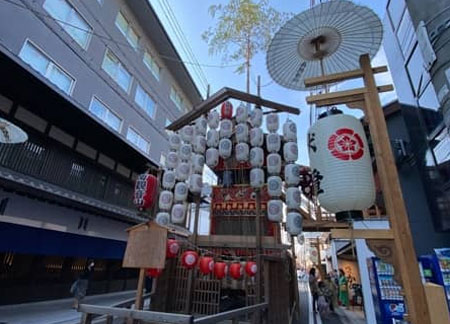
Update: See the latest blog on Gion Matsuri 2022 here.
Gion Festival fans around the world are wondering: will there be a Gion Matsuri 2022? What kind of shape will it take?
We won’t know until the Gion Matsuri Yamaboko Rengokai (Gion Festival Floats Association) makes an official announcement to the press, probably in early May. Until then, even the yamaboko floats communities don’t know for sure.
The Gion Matsuri’s roots go back to the 9th century. They formed around ending and warding off epidemics (read more about this in my book). Plagues were a regular problem in Kyoto, because of rainy-season conditions: heat, humidity, standing water, and a dense population. Also, this was before modern sanitation. Until antibiotics became available in Japan in the mid-20th century, Kyotoites still died of the “summer sickness.”
Gion Matsuri elders hold and transmit the matsuri’s traditions, which are largely experiential and oral. When these elders were children, family members and friends died of the summer sickness. So they still strongly feel that this is the Gion Festival’s raison d’ȇtre. To them, suspending the Gion Matsuri due to an epidemic is painfully ironic.
“It feels devastating that the Gion Festival has been suspended for two years in a row due to covid,” shared a former director of a Gion Festival float. “This is precisely the time for us to demonstrate the true power of this epidemic-eradicating festival. I’m praying for an end to the epidemic.
Gion Festival 2022: Who Decides What It Looks Like?
The Gion Festival’s structure is one of its most interesting features. Like an ecosystem or the human body, it’s a massive, semi-autonomous, interdependent, self-organizing system.
Yasaka Shrine is the parent shrine and determines what happens with the main Gion Matsuri deities. Yasaka Shrine has major input into, for example, whether and in what form its deities get transported off the Yasaka Shrine grounds. The Yasaka Shrine deities’ visit to downtown Kyoto comprises the spiritual heart of the Gion Matsuri.
Chonai: Yamaboko Floats Communities
Then there are 34 yamaboko floats communities. Each one has its own decision-making power and processes. Their commitment to holding the annual Gion Matsuri is backed by more than 1000 years of historical momentum. Generally speaking, they undertake to hold the annual Gion Matsuri as usual, unless conditions make this impossible. Then they look at what’s possible.
The Yamaboko Rengokai is a central organizing body for the floats. It’s particularly active liaising between the Gion Matsuri communities and various government entities, and with the media. But the Rengokai does not dictate policies.
Gion Matsuri and Government Bodies
Naturally, Kyoto City is a major stakeholder in the Gion Festival, as is Kyoto Prefecture. Kyoto’s “quasi emergency” status. In addition, the central government has some influence in the Gion Matsuri too. The Gion Matsuri floats’ communities possess many government-designated important cultural properties, and the central government provides funding to conserve and maintain these.
And of course, there are important public organizations that are working to keep Japan safe and healthy as we live through these years of covid together. No doubt their opinions will be carefully considered.
Being able to come to a consensus regarding such a historic and cultural institution like the Gion Matsuri, and among so many different stakeholders, speaks to the Japanese culture of wa, or harmony. This ethic is particularly strong in Kyoto.
On March 1 Prime Minister Kishida extended Kyoto’s quasi-emergency status until March 21, along with 17 other prefectures. On the other hand, Japan reopened its borders to non-Japanese nonresidents for the first time in three months.
Creating New Ways to Celebrate the Gion Matsuri
So here’s the big question: Can the Gion Festival community find a away to unleash the potential epidemic-eradicating power of Gion Matsuri 2022? While honoring the scientific and health imperatives in place to keep covid from spreading even more? What would you do in their position?
Here’s how the Gion Matsuri has unfolded during covid so far:
Gion Matsuri and Covid Recap
Buy my book, “Gion Festival: Exploring Its Mysteries,” to learn more about the spectacular Gion Festival than you can anywhere else. Some former directors of Gion Matsuri float associations have told me they believe it’s better than any books available on the Gion Matsuri in Japanese. Free excerpt available here.
Interested in sharing this content? Check out the Creative Commons Attribution-NonCommercial-ShareAlike 4.0 International License for guidelines on how. This is a cool way to grow a culture of generosity. In Buddhism, generosity is one of the foundational practices of spiritual enlightenment. So it’s worth a try.


